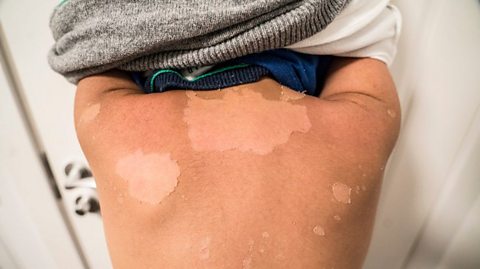This article was published in August 2019.
As June arrives and the Sun makes an appearance, the Great British Summer might finally be beginning.
And in typical British fashion, itÔÇÖs difficult to know whether we should be reaching for flip-flops or wellies at any given moment, which can make it difficult to know when to switch out the summer skincare routine.
But even if all you see is clouds, protecting your skin is important all year round, and not just during the hotter months. Plus, it's always handy to know your stuff, so you can plan in advance for your next adventure.
We've asked Sophie Cook, biochemist and writer of the blog The Scientific Beauty, to give us her protective skincare tips.
ItÔÇÖs not debatable: sun cream is a must!
YouÔÇÖve heard it a thousand times before from your elders, but it turns out they were right on this one. Sun cream really is important if youÔÇÖre heading out to enjoy the outdoors. Why though?
The Sun emits two types of harmful ultraviolet (UV) rays, UVA (long-wave) and UVB (shortwave), and itÔÇÖs important to protect your skin from both.
UVB rays are the ones that give you sunburn - but UVA rays can get into the deeper layers of the skin and cause lasting damage, which in turn can lead to premature skin ageing and even skin cancer.
Because of this, itÔÇÖs worth remembering that UVA rays can reach us even on a cloudy day - so itÔÇÖs always best to protect your skin if youÔÇÖre going to be outside for a long time.
A cream-based sun protection product that is reapplied throughout the day is the best way to avoid the effects of the Sun on your skin. Look for a sun cream that protects against both UVA and UVB rays to make sure youÔÇÖre covered.

Physical v chemical
There are two types of sun protection ingredients: physical and chemical ingredients.
Physical sun cream ingredients are mineral-based and reflect the SunÔÇÖs rays away from the skin. Look out for zinc oxide or titanium dioxide listed on the back: these protect your skin by blocking it from UVA and UVB rays.
However, sun creams with only these main protection factors tend to be thick and leave those dreaded white marks all over your skin. While nobody wants to look like streaky bacon, the bigger issue is that they rub off easily - especially when they get wet. This is why the bottles always advise reapplication after swimming.
Chemical sun cream ingredients absorb UV rays, and are particularly good against UVA rays. These manufactured compounds, such as octocrylene, are much lighter than the physical ingredients, so the cream may feel more comfortable to apply and wear.
But these chemical ingredients can often break down in the Sun after a while, which is why itÔÇÖs so important to reapply according to the label.

So which type of sun cream is best?
Your skin is unique to you, so this really depends on what works best for your individual skin type.
A product with a mixture of physical and chemical ingredients will provide the biggest range of protection for your skin - but what works great for one person, may not work for another.
For example, if you have sensitive skin you may find that chemical ingredients can irritate it. Or if you have acne, you may find that the thick physical ingredients could make your spots worse. ItÔÇÖs really worth experimenting (before you go out) with different brands until you find one that works for you.
Are there particular areas of the face we should pay attention to?
Sun cream should be worn over any part of your body that is exposed, but there are a few areas which need extra protection.
It's easy to avoid the eye areas when applying sun protection (we all know how much it can sting to get sun cream in your eyes!), but it's very important not to forget them: the skin on your eyelids and underneath your eyes is particularly thin and prone to UV damage.
We can also miss the places around our eyes that wrinkle and crease as we talk and laugh, leaving exposed areas - so cover it all and reapply throughout the day. Sunglasses can help prevent UV exposure in and around your eyes - not just a fashion statement!
A product that also benefits from having Sun Protection Factor (SPF) in it is lip balm - we often don't think about protecting our lips, but there is still skin there, and its skin that's also very thin and vulnerable to burns. A might be better for keeping lips hydrated and protected from the Sun, as many high-shine or glossy products an act as magnifiers to the Sun's rays and can worsen burns. Consider this when applying shiny highlighters or festival glitter, too - research the product first!
How about my hair?
Sun protection goes beyond our skin. We all know that our hair lightens in the summer - and while this might save us a trip to the hair salon, it doesn't come without damage. The Sun can not only bleach our hair, but also damage its structure, drying it out and leaving it feeling brittle and frizzy.
There are many sprays that have UV protection for our hair. You can also try replacing the lost oils in sun-damaged hair through deep conditioning treatments and leave-in oils, to help bring back that shine. And, of course, you can always wear a hat and prevent some of the damage in the first place.

Are there any products to avoid in the warm weather?
Take caution when using tanning oils and self-tanning lotions. While these are often found in sun care aisles of shops, they do not always contain sun protection, and are not a replacement for a sun cream. Also give extra consideration to your makeup: SPF foundation can be helpful, but is not a replacement for primary sun protection. We often apply less makeup than we would need to get the same effect as sun cream, and for it to keep working it would have to be reapplied every two hours. It's a good idea to use these products along with sun cream, but not as a substitute.
Skincare products containing acids should also be used with care in the sunny weather. Acids can be found in some acne products, popular exfoliating tonics and anything that claims to brighten skin.
Whilst these products can work wonders for your complexion, they work by stripping away the top layer of your skin - exposing paler, softer cells underneath that are more easily damaged by the Sun. If you know thereÔÇÖs a sunny spell due, maybe lay off these types of products for a while, or pay extra attention to your sun protection base.

Bronzing vs burning - is it better to fake it when it comes to a tan?
Definitely! A sun tan is caused by a pigment in the skin called melanin. It is produced as a response to being in the Sun as the skinÔÇÖs way of protecting itself from UV damage. Whilst you may tan easily and not burn very often, always remember that the skin darkens as a response to damage - so a ÔÇÿhealthy tanÔÇÖ isnÔÇÖt really a thing.
You should always be protecting your skin with sun cream even if you think you donÔÇÖt burn. This will prevent that UVA underlying damage and reduce the risk of getting skin cancer.
If youÔÇÖre desperate for that golden glow, fake tanning products can help you without the harm caused by UV exposure. Just do your research on whatÔÇÖs in them first and don't forget to apply a sun cream before hitting the beach.

Can any products help with sun damage?
Overexposure to the Sun is dangerous and it is very important to avoid burning in the first place.
When the skin is exposed to the SunÔÇÖs rays, molecules called free radicals are formed. These are nasty molecules which go around breaking up collagen and cell components in the skin. This is what leads to premature skin aging and the potential for skin cancer.
Vitamin E is known as an anti-oxidant, and helps the body to overcome these free radicals, easing the damage caused by the Sun. Creams with anti-inflammatory properties can soothe and protect skin from infection as it heals from sun damage. While anti-oxidants can't provide 100% protection from sun damage, itÔÇÖs worth using vitamin E-containing creams and sun aftercare even if you haven't burned - especially in the summer months.
There is some evidence that dietary anti-oxidants can provide UV protection in the skin. Foods that are high in vitamin E include nuts and seeds, leafy vegetables and egg yolks.
However, this doesnÔÇÖt mean that your kale and blueberry super smoothie can act as a replacement for sun cream either. When it comes to sun protection, preventing damage from the Sun will always be the best defense, rather than relying on the anti-oxidants to help afterwards. Skin damage caused by UV rays is irreversible and can have long-term consequences.
By getting into the habit of not only making sun care part of your skin routine but being mindful of exactly whatÔÇÖs in the products you use, youÔÇÖll make sun protection a priority for yourself all year round.
Remember: read the label, reapply and never go out for a long time without some form of sun protection!
If you notice any changes to your skin, or if youÔÇÖre in doubt, get it checked out by your GP. The British Association of DermatologistsÔÇÖ is an easy guide to checking your moles.
Hay fever, sunburn, spots and sweat marks: Summer myth busting with Dr Alex
We asked Dr Alex George to help us debunk some summer myths.

Why is it so hot?
What is a heatwave, and are our heatwaves becoming more frequent?

Chemistry: Skincare. revision-guide
Learn more about UV rays and how they affect your skin.
